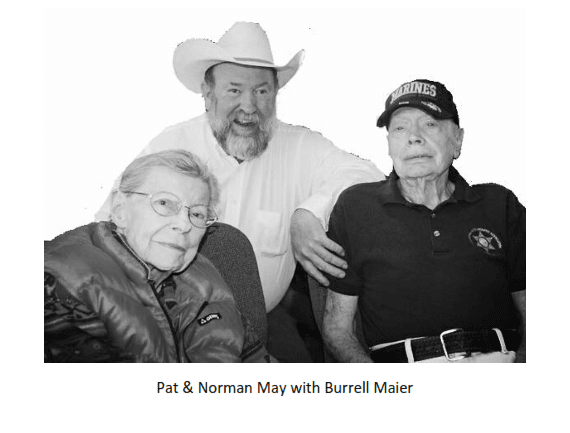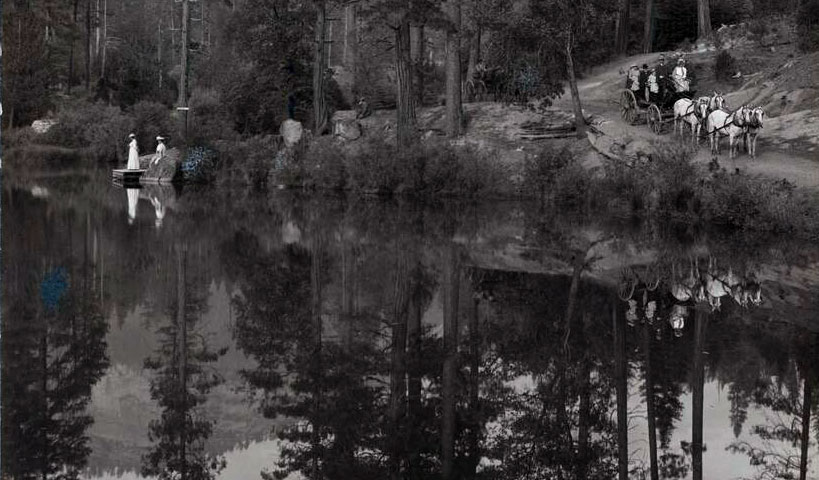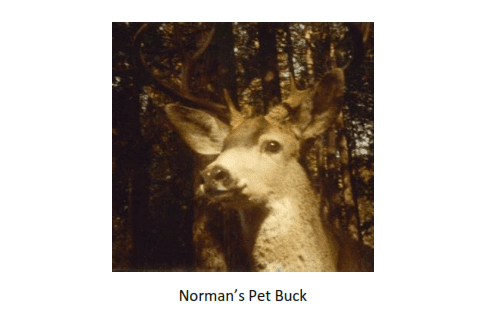
From the Recollections of Life and Events in Wawona series
By Norman May – The “C” Cabins; edited by Debbi Shelander
The May family arrived in Wawona on April 3rd, 1933. Norman’s father, Harold, was a rock crusher operator for Granite Construction. After a stay at Cambria in 1932 where Harold crushed rock for the original coastal highway from San Simeon to Morro Bay, he moved on to the next job, which was in Yosemite to build a new road from the South entrance to the tunnel. Harold set up the crusher near the Wawona campground, which was called Camp A. E. Wood at that time, named after the first Army superintendent of Yosemite who was based there. Also, it was called Camp Hoyle, named after Bert and Earnie Hoyle who had a store and a campground there.
The Mays, and other construction families, rented cabins at Camp Chilnualna from the owner, Cornelia McBeth Wooster, an ex-Spanish-American war nurse who had served with the Army in the Philippines. She had traded an apartment house in Oakland to the first owner and builder of Camp Chilnualna, Mr. Spelt, for the property. After moving to Sugar Pine in 1934, where Harold (still with Granite Construction) crushed the rocks to build the present road from the South Entrance to Oakhurst, the family returned to Wawona and purchased Camp Chilnualna from “Corny” (as she was called) and moved her to Imperial Beach below San Diego where she lived out her days.
Times were hard in those days. The depression was at its peak and sometimes Norman’s parents wondered if they had done the right thing by purchasing Camp Chilnualna, but they loved the place and they struggled on. “Corny” had operated a store on the property and the May’s continued this business as well as the cabin rentals.
Other than the Wawona Hotel, Camp Chilnualna was the only other tourist accommodations in Wawona. The Washburns had sold their holdings to the Park in 1932 and Curry Company had taken over the operation of the hotel and the Wawona store and post office. Clarence Washburn, a son, continued on as a manager for Curry Company until he moved to Indio or Palm Springs to manage a hotel there. As mentioned, times were hard in those long ago days.
To make matters worse, the heaviest and coldest winter in the memory of the white man arrived during the winter of 1936-37. The official measurement of snowfall was 16 feet of snow in 6 weeks, settling to a hard pack of 6 feet of “Sierra cement”. The temperature dropped to -28°below zero at Camp Chilnualna, -32° below zero at the CCC Camp, and Al Gordon had -37° below zero at his house up by the hotel. There were broken radiators all over Fresno and Merced (so said the papers), but we didn’t get damaged too badly. There were no power lines to get knocked down because we didn’t get power until 1948 and there were no water pipes to freeze because we didn’t have running water at that time. We carried our water in buckets from an old hand pump on a 12-foot well down in the creek behind our house, after we thawed out the pump with hot water! After our roof was shoveled (on top of the snow already on the ground) we had to tunnel up to get out of our house.
The worst damage from this cold spell was in the store at Camp Chilnualna. Soda pop bottles blew up and bottles of bluing (used in washing in those days) blew up as well. Some canned goods split. What a mess it was!
Chilnualna Falls road and Forest Drive were not plowed in those days. The locals parked their cars down at the Wawona store during the winters. School was held in the summer because the little children just couldn’t make it through the heavy snows that were the “norm” in those years. Some lived as far as a mile away from school (and NO, they didn’t have to walk barefoot!).
We had no propane during those years. Everyone, including Park personnel, burned wood for cooking and heating. We put up 30 to 40 tier of wood every fall to prepare for the winter (there are 4 tier to a cord). Another “norm” during those times was the outhouses that were used for toilets. What fun during those colds winters, especially the year it was 28 below! It was 11 years before we got a bathroom in the house. I grew up taking a bath in a washtub on the kitchen floor in front of the wood cook stove. This usually happened on a Saturday or Sunday. I suspect we got a little “gamey” toward the end of the week.
To make ends meet my dad had gone to work on the road for the Park. The pay was .52 cents an hour. The winter of 36-37 he plowed snow for 6 weeks straight without a break.
The following winter we had the biggest floods on record to that date. The publication called Yosemite Nature Notes has a chronology of the prior floods in Yosemite through the mid 40’s, and they called that flood “the Great Flood of 1937-38”. It came over Christmas and New Year. It washed out a long section of highway 140 between the Valley and El Portal. It also washed out the Indian bridge below Camp Chilnualna at what we call Flat Rock swimming hole today. It also washed out the Bossert house, which was located along the river just above Camp Chilnualna.
Further up, in the area where the Redwood Cabins are located today, the river totally changed its course. What had been river front property was no more. Many years later, Al Gordon put in a rock crusher in the old riverbed. After the flood of 1937-38 washed out the Indian Bridge, the CCC boys built another bridge just down river. It was called the CCC Bridge. This was in 1939. The next flood was in 1950. This flood took out the CCC Bridge and it was never replaced. The stone and cement steps leading up to the bridge are still in evidence today. It was during this flood that Big Tree Creek washed out a section of Highway 41 at the Park line beyond the South Entrance.
The next flood was in 1955. There was some debate as to whether these two “50’s” floods were bigger than the 1937-38 flood. I never did know what was decided about that. I also don’t know how the 1997 flood would rank with these predecessors. I think the powerhouse, which furnished electricity to the Wawona hotel and store, went out in the flood of 1950 also. It stood alongside the river just below the old schoolhouse on the south side of the river. It had a Pelton water wheel, which made electricity when the river was running good. When the river got low, a large one-cylinder generator with a big flywheel took over. By the time it washed out it was no longer in use anyway. P. G. and E. had started supplying electricity in 1948. Another casualty of the 1950 flood was Stella Lake. The dike, which made Stella Lake, washed out and that was quite a passing of Wawona history.

View of Stella Lake around 1900 taken by George Fisk. Courtesy of University of Southern California. Libraries and California Historical Society
Stella Lake was the ice pond, which furnished ice for the hotel, store and local iceboxes, not to mention many hours of wonderful ice-skating for the local residents. Eddy Gordon stretched a wire across the upper end of the lake, which was the boundary for ice-skating. The rest of the lake ice had to be kept clean and was reserved for ice cutting.
The ice-house was located at the lower end of the lake and 300 ton of ice was “put up” every winter, which was enough to supply all the community’s needs through the following summer. When the horses were driven out in the fall, Eddy Gordon always kept an old gray mare named Bell behind. Her duty was to be hitched up to the turnstile and go around driving the conveyor belt, which transported the chunks of ice up, into the ice-house.
The ice was cut by hand with ice saws which were special made for that purpose. We stood on 1 x 12 boards while sawing. This gave us a “straight edge” to saw to, enabling us to cut the ice in exact 12 inch widths. The 12 inch ice “rafts” were then floated to the lower end of the lake and into a chute where a man stood with a pitchfork breaking the ice into 12 inch chunks. From there it went onto the conveyor belt and into the ice-house where it was stacked in layers with sawdust spread between the layers.
The “locals” all looked forward to the ice-cutting time. It always came in December and was considered Christmas money. I don’t know what the pay was before the war, but by the time I started cutting in 1945, it was $1.25 an hour. I cut the last 3 years it was cut, 1945, 1946 and 1947. In 1948 when electricity arrived, there was no longer any need for the ice. Everyone had refrigeration and ice was made when needed. I forgot to mention that the ice cutting started when the ice was 6 inches thick. One year the ice was 12 inches thick by the time we finished cutting.
Getting back to the May family, we continued with the store that “Corny” had operated, making improvements and installing a 5,000 watt Kohler generator, which gave us electricity for the store, as well as one light globe in each of the nine cabins that were on the property.
There was a demand for “something to do”, so in 1938 my parents made an open-air dance floor. It extended out from the store building and then there was an opening cut in the side of the store to accommodate a jukebox, which faced out towards the dance floor. A fellow by the name of Ray Nichols had a string of jukeboxes spread out between here and Fresno. He installed the jukebox and kept it well supplied with the latest records, changing them every two weeks if some weren’t getting played much.
Between the CCC boys, the locals, and the people from the hotel, there was quite a crowd at Camp Chilnualna every night during the summer months. We let them dance until 9:00 p.m. on weeknights and Sunday, and 10:00 p.m. on Saturday nights. We also had a bonfire next to the dance floor with wooden 2 x 12 benches placed around it for those who wanted to toast marshmallows or hot dogs, or just sit by the fire.
In 1942 I took a “leave of absence” from Camp Chilnualna. I had just graduated from high school and I joined the Marines. I will never forget the first words of our D. I. (drill instructor) in boot camp, “You guys are hired killers and I am here to show you how to do it!” After a hasty 6 weeks of boot camp (prior to the war boot camp was 12 weeks) the “hired killers” were immediately sent to the Island of Midway to be on the reception committee for the expanding Japanese Empire. From there we made a bee-line for the Solomon Islands in the South Pacific to invite the Japanese to get out of New Georgia, Bouganville and a little known island called Emireau. I was gone for three years before returning to Camp Chilnualna, 20 months of which was spent in the South Pacific.
In 1949 Camp Chilnualna expanded even more. There was a demand for a restaurant other than the one at the hotel, so we built a restaurant and called it Chilnualna Lodge Café. At the same time two gentlemen approached us with a request to build a theatre on our property, so we leased a parcel of ground to them for that venture. At the same time, Al Gordon approached us with a request to build a service station and garage on our property, so we leased him a section of property to do so.
The theatre didn’t “fly” very well. There was a Pavillion Theatre in Yosemite Valley and another one at Bass Lake. Also the acoustics were not all that good in the Idlewilde Theatre, as it was called, because of the type of sheet rock construction.
After five years the two gentlemen gave it up and left. We then sold the building, except for the lobby and restrooms, to Mariposa County for a garage at their maintenance yard in Mariposa. We then built the large cabin you see there today on the site, utilizing the lobby and restrooms as part of the building.
Because of a misunderstanding with a partner, Al Gordon finally gave up the garage and service station. He moved the building to the Gordon ranch near Mariposa and we built cabin #17C on the site. In the meantime, we retired the store and dance floor and built cabin #18C on that site. The restaurant was going great. We had only been open a year (1950) when the worst happened.
The Korean War broke out, and even though I was in the inactive reserve, I was called back immediately for my specialty, MTACS (Marine Tactical Air Control), acting as a forward observer calling in air strikes on enemy positions. However, I was lucky, after 13 months and practically upon the eve of my departure for Korea, the high command decided that because of my extensive service in World War II, I had enough. They gave me the option of going or getting out. Needless to say, I chose the latter.
I have wandered far a-field from Camp Chilnualna and Wawona, but I wanted to mention how much my getting called back into the Marines disrupted our lives and the course of events for Camp Chilnualna. It was impossible for my parents to continue on trying to run the cabins and restaurant in my absence. So the restaurant was leased out to a gentleman by the name of John Steele. This was a good move. He was a good operator and it relieved the pressure on my parents until I could get home again.
After I came home in October of 1951, things went well for several years until the death of my dear mother in September of 1960. This kind of threw things out of “gear” again. My mother was a strong woman. She was born and raised in the rough mining camps of Montana. She knew what hard work was and wasn’t afraid of it. I must say that her strength, perseverance and tenacity was the glue that held Camp Chilnualna together in the early days.
At this time, I want to mention another lady of strength and resourcefulness who contributed much to the affairs and guidance of Wawona. I went to high school in Fresno with a very pretty girl named Marie Kauffung. Imagine my surprise when many years later this same girl appeared in Wawona. Her name by this time was Escola. She became the lady mentioned above. Wawona owes a lot to her. It is too bad she was taken from us so early.

Read more stories from “Recollections of Life and Events in Wawona” stories

